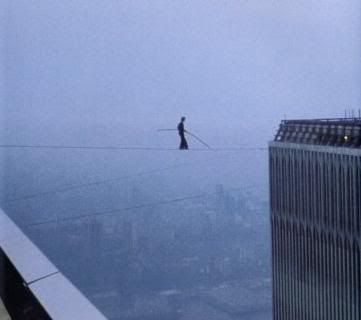
In his
Village Voice review
J. Hoberman writes that Eric Rohmer's latest film, the 5th-century set
The Romance of Astrée and Céladon "feel[s]... oddly contemporary," but for me much of the film's appeal is just how foreign it seems to a modern sensibility. Adapted from Honoré d'Urfé's 17th-century pastoral novel, the film not only transports us to a world of nymphs and druids and vast swaths of unspoiled land - which Rohmer films in a kind of quiet, contemplative rapture - but to a seemingly antiquated moral universe (although perfectly in keeping with the director's Catholic conservatism) in which love is capable of effecting true spiritual union and the love-play of the young consists primarily in a series of exaggeratedly romantic gestures.
In fact it's just such an exaggerated gesture that sets the film's narrative in motion. When Astrée (Stéphanie Crayencour), in a moment of pique, forbids her lover Céladon (Andy Gillet) from ever seeing her again, the young man immediately announces his attention to drown himself and proceeds to jump into the nearest river. Surviving his suicide attempt and determined to uphold the letter of his lover's law, he skulks about the outskirts of the country, spurning human interaction, forbidding himself to come into contact with his beloved. Astrée, for her part, believes Céladon to be dead and spends much of the film pining away for her absent beau.
For a film that spends so much time keeping its lovers apart,
Romance brims over with a joyousness at the prospect of an unspoiled romantic consummation, a concept that Rohmer treats with dead seriousness and is unafraid to depict in lovingly sensuous terms. When Céladon stumbles across a sleeping Astrée, his eyes - and Rohmer's camera - move down over her exposed thigh, the whole thing played off with soft, bright lighting, granting the scene a sense of spiritual/erotic rapture. Then the two moments of embrace between the lovers - the first in flashback, the second the film's final reconciliation in which Céladon, disguised in drag, reveals himself to Astrée and the two come together in a gender-blurred finale - are unusually intimate, eschewing the measured precision that dulls most on-screen kisses. As
Dan Callahan notes, the lover's embrace is "so private that it's almost embarrassing to watch." Embarrassing, perhaps, but undeniably moving.
Rohmer adds some gravitas to the otherwise joyous proceedings by intercutting a pair of moral/theological lectures into the narrative. In the first of these interludes, a druid priest gives Céladon a lesson in Celtic religion, which sounds surprisingly like a Catholic priest explaining the Trinity. Whereas Céladon believed that the different "minor gods" worshiped by the Celts were unique entities, the priest explains that they are all really just aspects of the one true God. While this segment seems to have little purpose apart from serving as further elucidation of the director's rather doctrinaire beliefs, another interpolated sequence - a disquisition on the coming together of two souls in romantic unity - seems more to the point. The discussion plays out as a debate between a committed couple of young lovers (Céladon's brother and his wife) and a debauched (and insufferably irritating) dandy who sings the praises of bodily pleasures and multiple partners. Rohmer may, as
Akiva Gottlieb notes, "stack the deck in favor of his moral conservatism" by putting the dissenting argument in the mouth of an obvious "buffoon" but to insist on a nuanced dialectic is to miss the point. It may be difficult to accept such a seemingly outmoded romantic ethos, but Rohmer's commitment to presenting a moral universe in which a spiritual (as well as sensual) consummation is achievable should not be taken lightly. When Astrée and Céladon finally join together at film's end, the director's prior establishment of the intellectual grounding for their union provides an added emotional weight to the long hoped-for coupling. Accepting Rohmer's world on its own terms, we, along with the young lovers, are granted a taste of the sublime.
 [Editor's Note: This review is part of the Bosomania!: The Sex, the Violence, and the Vocabulary of Russ Meyer feature at Not Coming to a Theater Near You.]
[Editor's Note: This review is part of the Bosomania!: The Sex, the Violence, and the Vocabulary of Russ Meyer feature at Not Coming to a Theater Near You.]





